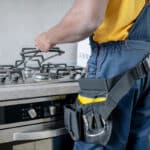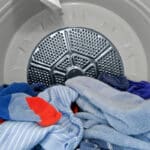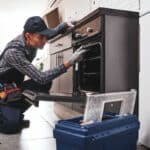My dryer won’t heat – help! The ability to do laundry in your own home saves families time and money. Unfortunately, heating issues are one of the most common issues families experience with their dryer. If the heating element in your dryer stop working completely, you could find yourself passing hours at a laundry mat. Thankfully, there are only a few parts that cause most heating issues in electric and gas dryers. Although it’s possible to replace any of these pieces yourself, working with a local Colorado Springs dryer repair specialist is recommended to ensure the appliance is repaired properly and safely. Here is a list of common causes of a dryer not heating.
Electric Dryers:
Electric dryers are easy to use, but they can be incredibly dangerous to work on without the right tools. Take a look at the most likely causes of heat loss in an electric dryer before calling a specialist. These are the most common causes of a dryer not heating.
Faulty Heating Coils:
Inside of your electric dryer is a small copper coil. Known as the “heating coil,” this component is responsible for creating and distributing heat throughout the appliance. The heating coil can be tested with a “hot stick,” (also known as an electrical continuity tester) to check for power. If the coil is broken or damaged, replace it using this step-by-step guide.
Damaged Thermostat:
Thermostats are safety features that monitor the internal heat of your dryer. If excess heat is detected, the thermostat automatically “raises the alarm” by halting heat production.
There are two reasons your thermostat may cause a heating problem:
- Clogged Vents: If the exhaust vents in your dryer become clogged, the trapped heat will increase the internal temperature of the appliance and trigger the thermostat. If clogged vents are the issue with your machine, clear out the lint screen and air vent.
- Broken Part: Occasionally, thermostats stop working due to wear and tear. Thankfully, you can replace the part itself for a fraction of the cost it would take to buy a new dryer. To determine if the thermostat in your dryer is broken, contact your Colorado Springs dryer repair specialist and request an inspection.
Cycling Thermostats:
Cycling thermostats are responsible for regulating the temperature within the drying drum. As clothes tumble, the cycling thermostat regulates the amount of heat traveling into the drum. When this part begins to malfunction, it could cause the dryer to stop producing heat entirely.
Gas Dryers
Gas dryers are uncommon in the Front Range, but not obsolete. If you have a gas dryer that has stopped heating, the cause is likely one of the three pieces listed below:
Igniters:
The igniter is responsible for creating a spark to generate heat. When it malfunctions, the dryer will stop producing heat immediately. If you decide to check this component yourself, disconnect the dryer’s power source and gas hookups before starting.
Radiant Flame Sensors:
The radiant flame sensor is responsible for monitoring the pilot flame in your dryer. If the flame does not ignite or isn’t producing enough heat to trigger the flame sensor, the sensor notices this and stops heat generation. When this sensor starts to malfunction, the dryer could stop heating as a safety precaution.
Control Valve:
Too much gas in a dryer’s ignition chamber can cause serious safety issues. To moderate the amount of gas that enters the ignition area, gas dryers feature a “control valve” that allows gas to safely flow to the ignitor. If the valve breaks or stops functioning correctly, the heating elements will also stop working.
Dryers are powered by 240 volts of electricity, making them extremely dangerous to repair for individuals who aren’t prepared with the right tools or experience. Rather than risk your safety, get your dryer fixed quickly by enlisting the help of a professional Colorado Springs appliance repair service.




